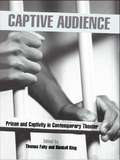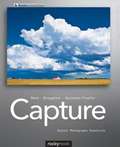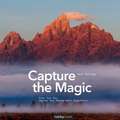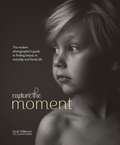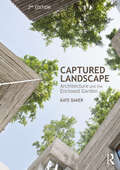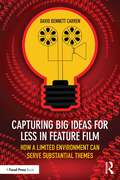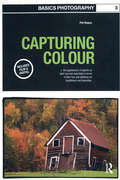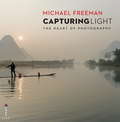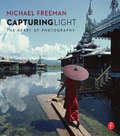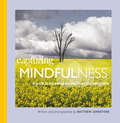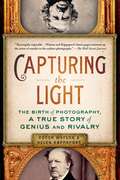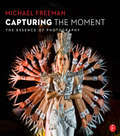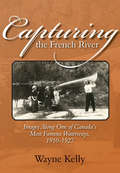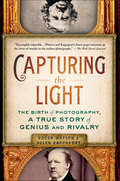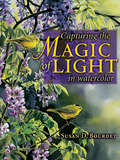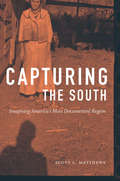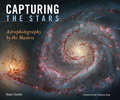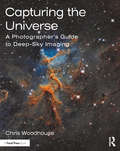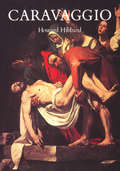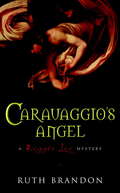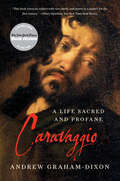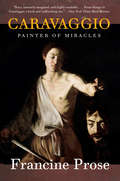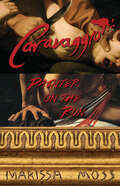- Table View
- List View
Captive Audience: Prison and Captivity in Contemporary Theatre (Studies in Modern Drama #19)
by Thomas Fahy Kimball KingThe first collection on this important topic, Captive Audience examines the social, gendered, ethnic, and cultural problems of incarceration as explored in contemporary theatre. Beginning with an essay by Harold Pinter, the original contributions discuss work including Harold Pinter's screenplays for The Handmaid's Tale and The Trial, Theatrical Prison Projects and Marat/Sade. Kimball King, Thomas Fahy, Rena Fraden, Tiffany Ana Lopez, Fiona Mills, Harold Pinter, Ann C. Hall, Christopher C. Hudgins, Pamela Cooper, Robert F. Gross, Claudia Barnett, Lois Gordon
Capture
by Glenn Rand Chris Broughton Amanda Quintenz-FiedlerIn film-based photographic education, strong programs and writings have placed great emphasis on making a negative. But to get to the negative, good exposure is required. The beginning of the photographic process significantly affects the final outcome of an image - a fact that has not changed with digital photography. Capture: Digital Photography Essentials concentrates on photography from a digital-capture workflow point of view. The text addresses both the opportunities and limitations of digital photography, and how to work with those opportunities and around the limitations. Authors Glen Rand, Chris Broughton, and Amanda Quintenz-Fiedler discuss the digital tools that allow photographers to capture, create, and maintain high-quality digital photographs. Readers will learn to maximize the potential of their images through an understanding of the core principles and more advanced aspects of the digital photographic process. Various projects that are based on tested teaching concepts for digital photography can be found throughout the text, as well as numerous images that are both inspirational and instructional. Topics include: Digital Cameras Sensors and Lenses Basic Exposure Digital Exposure Digital Capture Workflow Image Files Parametric Editing Digital Zone System HDRI Hybrid Imaging Capture Technology
Capture the Magic
by Jack DykingaThis book uses a structured approach to teach the art of creating interesting, well-composed images. It provides solutions to problems that often get in the way of producing great photographs and emphasizes the importance of training the eye to exclude the extraneous. Examples of strong images are juxtaposed against flawed images, illustrating how to create a successful composition. Topics covered include light and shadow, lens choice, framing, negative space, and many more. In this book, author Jack Dykinga encourages us to look at photography as a way to communicate. Dykinga says, "Photography is a marvelous language that crosses linguistic borders as a universal, powerful, and direct communication. As photographers, we see something we find interesting and simply want to share it." Readers will learn new ways to create interesting and powerful compositions that communicate their intended messages. Filled with beautiful color images throughout, the book is sure to inspire, teach, and motivate photographers of all levels.
Capture the Moment
by Sarah WilkersonThis modern guide to photography pairs big, bold images with short, focused tips for translating everyday life into stunning works of art. Featuring contributions by the members of Clickin Moms, the photography industry's largest social network of female photographers, this guide captures the beauty of family life--whether it's a child's unfinished bowl of cereal or a sunlit trip to the lake. With tips progressing from elementary to advanced, this book is perfect for amateurs and professionals alike, covering equipment, composition, posing, low light, natural light, black and white, still life, and lifestyle photography. Assignments for experimenting with lighting and shooting locations round out the chapters, providing photographers with both the inspiration and skills they need to document those unforgettable, frame-worthy moments in time.From the Hardcover edition. photography, the example shots feature plenty of inspiration for photographing children as well as other beautiful everyday moments. Assignments for experimenting with lighting and shooting locations round out the chapters, providing every photographer with both the inspiration and skills she needs to capture life's beautiful moments as frame-worthy photographic art.
Captured Landscape: Architecture and the Enclosed Garden
by Kate BakerThe enclosed garden, or hortus conclusus, is a place where architecture and landscape come together. It has a long and varied history, ranging from the early paradise garden and cloister, the botanic garden and giardini segreto, the kitchen garden and as a stage for social display. The enclosed garden has continued to develop into its many modern forms: the city retreat, the redemptive garden, the deconstructed building. As awareness of climate change becomes increasingly important, the enclosed garden, which can mediate so effectively between interior and exterior, provides opportunities for sustainable design and closer contact with the natural landscape. By its nature it is ambiguous. Is it an outdoor room, or captured landscape; is it architecture or garden? Kate Baker discusses the continuing relevance of the typology of the enclosed garden to contemporary architects by exploring influential historical examples and the concepts they generate, alongside some of the best of contemporary designs – brought to life with vivid photography and detailed drawings – taken primarily from Britain, the Mediterranean, Japan and North and South America. She argues that understanding the potential of the enclosed garden requires us to think of it as both a design and an experience. Captured Landscape provides a broad range of information and design possibilities for students of architectural and landscape design, practising architects, landscape designers and horticulturalists and will also appeal to a wider audience of all those who are interested in garden design. This second edition of Captured Landscape is enriched with new case studies throughout the book. The scope has now been broadened to include an entirely new chapter concerning the urban condition, with detailed discussions on issues of ecology, sustainability, economy of means, well-being and the social pressures of contemporary city life.
Capturing Big Ideas for Less in Feature Film: How a Limited Environment Can Serve Substantial Themes
by David Bennett CarrenThis book is an accessible guide, directed towards filmmakers with restricted resources and shortened schedules, who want to ensure their creation of riveting, fresh, and exciting projects. Whether a film is produced under a low or high budget, this text emphasizes that a small world coupled with a big idea can serve strong themes, complex characters, and powerful stories.Award-winning screenwriter David Carren suffuses this book with his own, original Narrative Synonym Process, teaching readers how to redevelop and expand a single idea or element in a story into multiple directions. Each chapter examines case studies of successful films and screenplays that are suitable to the subject. Script to Screen entries evaluate specific scenes in well‑known films in relation to their dramatic intention and budgetary costs. The end of each chapter includes a review of its basic points and a bibliography citing the companies that produced the film, or the publishers of their scripts and/or where to find them, along with an exercise to allow the reader to directly enhance their knowledge and education.Offering a variety of exercises throughout to allow the reader to directly enhance their knowledge and education, this text is an essential resource for film students, screenwriters and filmmakers who want to make strong, successful films from limited resources.
Capturing Colour: Capturing Colour (Basics Photography)
by Phil MalpasBasics Photography 03: Capturing Colour gives readers a comprehensive introduction to the subject of colour and how to master its use in the process of photographic image-making. The topics discussed range from basic colour theory to the colour temperature of light and how to use colour to maximize the impact of compositions. A full and intimate understanding of colour is vital to the creation of dramatic, emotive and powerful photographic images. The way we choose to use colour will greatly influence the success of our image-making.
Capturing Light in Oils: A Step-by-Step Guide by a Master of Painting Light
by Paul Strisik"I feel that God's sunlight on a single blade of grass is such a miracle and so difficult to capture in paint, it is worth a lifetime of trying"--Paul Strisik Legendary artist Paul Strisik, N.A., A.W.S., was not the kind of artist you'd find cooped up inside a studio. As one of the great plein air painters of his generation, Paul preferred to be outdoors using the sun to light his subjects. His years of experience in capturing that natural light are offered here in Capturing Light in Oils. In these pages, Paul Strisik presents a step-by-step approach to using the three most powerful tools an artist can employ--design, color, and light. Using the techniques taught in this book, Strisik teaches how to use natural conditions to your advantage to create artwork that truly expresses your vision.
Capturing Light: The Heart Of Photography
by Michael FreemanIn almost all photography it's the quality of light that makes or breaks the shot. For professional photographers, chasing the light, waiting for it, sometimes helping it, and finally capturing it is a constant preoccupation -- and for some an obsession. Drawing on four decades of doing just this, Michael Freeman takes a simple but practical approach to reacting to, and capturing photography's most important commodity. There are just three sections titled Waiting, Chasing, and Helping: Waiting explains the kinds of lighting that photographers can anticipate and plan for, while Chasing explores the transient, serendipitous light that photographers have to work quickly to exploit. Helping, the final and most technical section, focuses on the skills and techniques for enhancing, reducing, or otherwise controlling light, covering everything from in-the-field shooting choices to technical transformations to post-production.
Capturing Light: The Heart of Photography
by Michael FreemanIn almost all photography it’s the quality of light that makes or breaks the shot. For professional photographers, chasing the light, waiting for it, sometimes helping it, and finally capturing it is a constant preoccupation — and for some an obsession. Drawing on four decades of doing just this, Michael Freeman takes a simple but practical approach to reacting to, and capturing photography’s most important commodity. There are just three sections titled Waiting, Chasing, and Helping: Waiting explains the kinds of lighting that photographers can anticipate and plan for, while Chasing explores the transient, serendipitous light that photographers have to work quickly to exploit. Helping, the final and most technical section, focuses on the skills and techniques for enhancing, reducing, or otherwise controlling light, covering everything from in-the-field shooting choices to technical transformations to post-production.
Capturing Mindfulness
by Matthew JohnstoneThere are few better ways to consciously slow down and truly engage with your surroundings than when you are armed with a camera. With Capturing Mindfulness, de-stressing and being in the moment needn't be limited to simple diary-keeping and fill-in journals; instead you can capture it with your lens. Bestselling author Matthew Johnstone's latest book Capturing Mindfulness, is a natural follow on from his last book Quiet the Mind which came out in 2012.Matthew has been practicing what he terms 'photopresent' for the last 15 years and believes that next to meditation, this is one of the most creative and enjoyable ways to attain mindfulness in day-to-day life. The very essence of photography; after all, is all about focus and capturing 'the moment'.Matthew is fascinated by light, colour, composition and most importantly how he can see the world differently. For him, having camera in your hands is the reminder to consciously slow everything down from your breath, to your walk, to your thoughts and begin to really observe your surroundings as if seeing them for the first time.Mindfulness photography is about seeing something that no one else can, capturing something that will never happen again and finding beauty where it doesn't typically exist. When we become more consciously aware of where we are, what we're doing and what we're thinking, life can become calmer, more enjoyable and generally more manageable.
Capturing The Light: The Birth Of Photography, A True Story Of Genius And Rivalry
by Helen Rappaport Roger WatsonAn intimate look at the journeys of two men―a gentleman scientist and a visionary artist―as they struggled to capture the world around them, and in the process invented modern photography During the 1830s, in an atmosphere of intense scientific enquiry fostered by the industrial revolution, two quite different men―one in France, one in England―developed their own dramatically different photographic processes in total ignorance of each other's work. These two lone geniuses―Henry Fox Talbot in the seclusion of his English country estate at Lacock Abbey and Louis Daguerre in the heart of post-revolutionary Paris―through diligence, disappointment and sheer hard work overcame extraordinary odds to achieve the one thing man had for centuries been trying to do―to solve the ancient puzzle of how to capture the light and in so doing make nature 'paint its own portrait'. With the creation of their two radically different processes―the Daguerreotype and the Talbotype―these two giants of early photography changed the world and how we see it. Drawing on a wide range of original, contemporary sources and featuring plates in colour, sepia and black and white, many of them rare or previously unseen, Capturing the Light by Roger Watson and Helen Rappaport charts an extraordinary tale of genius, rivalry and human resourcefulness in the quest to produce the world's first photograph.
Capturing The Moment: The Essence of Photography
by Michael FreemanThis is not a book about the fundamentals of shutter speed or how your camera works; it is a book that will teach photographers of all levels how to work with their cameras to capture moments whether they are occurring quickly or unfolding over many hours. Capturing the Moment is about a gesture, an expression, a ball in the net, a whale breaching, like Marilyn Monroe’s skirt flying up or Alfred Eisenstaedt’s image of a kiss between a soldier and nurse in Times Square. Moments in all forms are the true core of photography, and this book will explain how to anticipate them, recognise them, choose them, and capture them, through the eyes and wisdom of award-winning photographer and celebrated author Michael Freeman.
Capturing the French River: Images Along One of Canada's Most Famous Waterways, 1910-1927
by Wayne KellyCapturing the French River introduces a rare collection of exceptional photographs taken along the river between 1910 and 1927 by Doctors J. Ernest Rushbrook and Frank Sherman, whose lifelong friendship was based in part around their mutual love of photography, of nature, of the Canadian wilderness and of the canoe. The collection was a serendipitous discovery by author Wayne Kelly, who immediately recognized the uniqueness of these incredible images. The two Rushbrook sisters, Ida and Bertha, also photographers, play a significant role in this book on the amazing, historically significant French River and the once-thriving original village of French River, which ceased to exist circa 1924. The sisters are remembered as well for their fearless running of whitewater rapids and remote camping adventures, often including Bertha’s son, Max, who was still a babe in arms.The author’s historical research on this area and the era has led to an informative text that will delight history buffs and also serve as the ideal companion for those interested canoeists and travellers venturing into French River country. Present-day photographers will also be intrigued by the many images selected from a collection of 634 photographs. Capturing the French River is destined to become a Canadian treasure in print.
Capturing the Light: The Birth of Photography, a True Story of Genius and Rivalry
by Helen Rappaport Roger WatsonAn intimate look at the journeys of two men—a gentleman scientist and a visionary artist—as they struggled to capture the world around them, and in the process invented modern photographyDuring the 1830s, in an atmosphere of intense scientific enquiry fostered by the industrial revolution, two quite different men—one in France, one in England—developed their own dramatically different photographic processes in total ignorance of each other's work. These two lone geniuses—Henry Fox Talbot in the seclusion of his English country estate at Lacock Abbey and Louis Daguerre in the heart of post-revolutionary Paris—through diligence, disappointment and sheer hard work overcame extraordinary odds to achieve the one thing man had for centuries been trying to do—to solve the ancient puzzle of how to capture the light and in so doing make nature 'paint its own portrait'. With the creation of their two radically different processes—the Daguerreotype and the Talbotype—these two giants of early photography changed the world and how we see it. Drawing on a wide range of original, contemporary sources and featuring plates in colour, sepia and black and white, many of them rare or previously unseen, Capturing the Light by Roger Watson and Helen Rappaport charts an extraordinary tale of genius, rivalry and human resourcefulness in the quest to produce the world's first photograph.
Capturing the Magic of Light in Watercolor
by Susan D. BourdetTransform your paintings from ordinary to extraordinary - with light! Want to paint light-filled watercolors that reach out and draw viewers in? In this book, award-winning watercolorist and teacher Susan Bourdet shows you how. Through simple concepts and detailed step-by-step demonstrations, Susan demystifies the process of successfully depicting light in watercolor. You'll learn how to: Create convincing light effects and rich shadows Depict different light angles and times of day Render light on a variety of subjects, from feathers and fur to flowers, water and textures Take reference photos with exciting light and combine them into a believable composition that speaks to your viewers It's all the information you'll need to capture the magic of light in your watercolors! Includes 23 step-by-step demonstrations!
Capturing the South: Imagining America's Most Documented Region (Documentary Arts and Culture, Published in association with the Center for Documentary Studies at Duke University)
by Scott L. MatthewsIn his expansive history of documentary work in the South during the twentieth century, Scott L. Matthews examines the motivations and methodologies of several pivotal documentarians, including sociologist Howard Odum, photographers Jack Delano and Danny Lyon, and music ethnographer John Cohen. Their work salvaged and celebrated folk cultures threatened by modernization or strived to reveal and reform problems linked to the region's racial caste system and exploitative agricultural economy. Images of alluring primitivism and troubling pathology often blurred together, neutralizing the aims of documentary work carried out in the name of reform during the Progressive era, New Deal, and civil rights movement. Black and white southerners in turn often resisted documentarians' attempts to turn their private lives into public symbols. The accumulation of these influential and, occasionally, controversial documentary images created an enduring, complex, and sometimes self-defeating mythology about the South that persists into the twenty-first century.
Capturing the Stars: Astrophotography by the Masters
by Robert GendlerPortraits of the deep sky and of local astronomical phenomena taken by the world&’s renowned astrophotographers—with a foreword by Neil deGrasse Tyson. To gaze at the stars is one thing; to capture that gaze in photographs is something else, a tantalizing scientific art that many attempt and few master. That rare mastery is on full display in this beautiful volume of space photography from thirty of the most accomplished astrophotographers in the world, both professional and amateur. Galaxies, star clusters, nebulae, and other deep-sky treasures fill the pages. Along with the marvels of the night sky—the Andromeda and Whirlpool galaxies, the Pleiades and the Praesepe, the Orion and Crab nebulae, and many more—each section features a profile of the photographer&’s work, techniques, philosophy, and experiences. Compiled by the world&’s leading amateur astrophotographer, with an introduction to the history of space photography, this spectacular volume is an essential for every stargazer&’s bookshelf.elf.
Capturing the Universe: A Photographer’s Guide to Deep-Sky Imaging
by Chris WoodhouseThis book provides a thorough introduction to and exploration of deep sky astrophotography for the digital photographer. With over 280 images, graphs, and tables, this introductory book uses a progressive and practical style to teach readers how to image the night sky using existing, affordable equipment. The book opens with a brief astronomy primer, followed by chapters that build progressively to explain the challenges, offer solutions, and provide invaluable information on equipment choice through image capture, calibration, and processing in affordable software. The book’s focus ranges from how to image sweeping vistas and star trails using only a camera body, lens and tripod, to more advanced methods suitable for imaging galaxies, clusters, nebulae, and stars. Other features of the book include: Real-world assignments showing how and when to use certain tools and how to overcome challenges and setbacks Practical construction projects Evaluations of the most recent developments in affordable hardware and software Exploration on how sensor performance and light pollution relate to image quality and exposure planning Ground-breaking practical chapters on lucky imaging and choosing and using the latest CMOS cameras Written in an accessible, easy to follow format, this comprehensive guide equips readers with all the necessary skills to progress from photographer to astrophotographer.
Capturing the Women's Army Corps: The World War II Photographs of Captain Charlotte T. McGraw
by Francoise Barnes Bonnell Ronald Kevin BullisThe photographs taken by Charlotte T. McGraw, the official Women&’s Army Corps photographer during World War II, offer the single most comprehensive visual record of the approximately 140,000 women who served in the U.S. Army during the war. This collection of 150 of McGraw&’s photos includes pictures made in Africa, in England at the headquarters of the European Theater of Operations, in Asia and the Pacific, and in military hospitals in the United States.Serving from July 1942 to August 1946, Captain McGraw provided more than 73,000 photographs to the War Department Bureau of Public Affairs. Her photographs were published in the New York Times, New York Herald Tribune, and used by the Associated Press and the United Press, as well as in recruiting posters, handouts and informational pamphlets, and in the most popular magazines of the era such as Time, Colliers, Women&’s Home Companion, Parade, Saturday Evening Post, and Mademoiselle.
Caravaggio (Icon Editions Ser.)
by Howard HibbardCaravaggio was one of the most important Italian painters of the 17th century. He was, in fact, the wellspring of Baroque painting. In Hibbard's words, Caravaggio's paintings "speak to us more personally and more poignantly than any others of the time". In this study, Howard Hibbard evaluates the work of Caravaggio: notorious as a painter-assassin, hailed by many as an original interpreter of the scriptures, a man whose exploration of nature has been likened to that of Galileo.
Caravaggio's Angel
by Ruth BrandonDr. Reggie Lee, new at London's National Gallery, is planning a small exhibition of three almost identical Caravaggio paintings when she discovers a fourth. One must be a forgery. That discovery detonates multiple murders. Like Flavia di Stefano in Iain Pears' art history mysteries, Reggie is attractive, knowledgeable when it comes to art, and percipient when it comes to people with motives to defraud.
Caravaggio: A Life Sacred and Profane
by Andrew Graham-DixonA New York Times Book Review Editors' Choice and a Washington Post Notable Book of the Year "This book resees its subject with rare clarity and power as a painter for the 21st century." —Hilary Spurling, New York Times Book Review Michelangelo Merisi da Caravaggio (1571–1610) lived the darkest and most dangerous life of any of the great painters. This commanding biography explores Caravaggio’s staggering artistic achievements, his volatile personal trajectory, and his tragic and mysterious death at age thirty-eight. Featuring more than eighty full-color reproductions of the artist’s best paintings, Caravaggio is a masterful profile of the mercurial painter.
Caravaggio: Painter of Miracles (Eminent Lives)
by Francine Prose“Matching gorgeous prose to gorgeous artworks, Prose responds to each image as a moment of theatrical revelation, sensual or spiritual, and frequently both.” — Boston Sunday GlobeIn Caravaggio, New York Times bestselling author Francine Prose offers an enthralling account of the life and work of one of the greatest painters of all time. Caravaggio defied the aesthetic conventions of his time; his use of ordinary people, realistically portrayed—street boys, prostitutes, the poor, the aged—was a profound and revolutionary innovation that left its mark on generations of artists. His insistence on painting from nature, on rendering the emotional truth of experience, whether religious or secular, made him an artist who speaks across the centuries to modern day. Called “racy, intensely imagined, and highly readable” by the New York Times Book Review, Caravaggio includes eight pages of color illustrations, and is sure to appeal to art enthusiasts interested in one of history’s true innovators. Caravaggio is part of the “Eminent Lives” series from HarperCollins, a selection of biographies by distinguished authors on canonical figures
Caravaggio: Painter on the Run
by Marissa MossCaravaggio was on a defiant mission to change the art world. Before him, there were pastel-colored idealized visions, polite paintings for a polite society. After him, there were slews of imitators, trying to grasp his brilliant slashes of light and dark, his people who looked more like your neighbor than a model of perfection. Bold with his brush, the young rebel was equally brash in his life, picking fights and getting arrested for things as silly as throwing a plate of artichokes in a waiter's face. Until he faced the ultimate punishment, condemned for a murder he didn't commit—at least not intentionally.
